The GPU benchmarks hierarchy 2025: Ten years of graphics card hardware tested and ranked
We've run hundreds of GPU benchmarks on Nvidia, AMD, and Intel graphics cards and ranked them in our comprehensive hierarchy, with over 80 GPUs tested.
GPU Benchmarks Introduction

Our GPU benchmarks hierarchy ranks all the current and previous generation graphics cards by performance, and Tom's Hardware exhaustively benchmarks current and previous generation GPUs, including all of the best graphics cards. Whether it's playing games, running artificial intelligence workloads like Stable Diffusion, or doing professional video editing, your graphics card typically plays the biggest role in determining performance — even the best CPUs for Gaming take a secondary role.
With 2025, the new GPU releases have been coming fast and furious. Intel kicked things off with the Arc B580 at the end of 2024, followed by Arc B570 in January. Nvidia announced its Blackwell RTX 50-series architecture at CES 2025, then launched the RTX 5090 and RTX 5080 in late January, the RTX 5070 Ti in February. The biggest problem with nearly all of those GPUs? You can't buy them at MSRP, or sometimes even at all.
The AMD RX 9070 XT at $599 and RX 9070 at $549 arrived on March 6, one day after Nvidia's RTX 5070 at $549 launched. We've tested those cards as well and have updated the GPU hierarchy. Naturally, they sold out as well. It's not that we don't want more affordable graphics cards; it's that AI is all the rage, commanding billions of dollars in sales. It accounted for nearly 90% of Nvidia's record-setting $130 billion in annual revenue for last fiscal year. Gaming was just under 9% of the total.
A big part of the problem is also that Nvidia and AMD seemingly made some planning errors with the transitions from the prior generation to the new / upcoming hardware. Demand for the prior generation didn't dry up, and basically all the RTX 40-series GPUs and RX 7000-series GPUs went out of stock, with the exception of the base model RTX 4060 and RX 7600. That started to happen several months ago, leaving a gaping hole of demand for the new GPUs.
Inventory ran out before the new GPUs were ready, creating a backlog of people wanting to upgrade GPUs. Couple that with an inadequate supply of Nvidia's RTX 50-series cards that have launched and you basically can't find a reasonably priced graphics card. And then there are new tariffs coming into effect that could further impact prices and availability. It's a perfect storm hitting the graphics market yet again.
The good news? Some of the latest graphics cards have been available at prices closer to their respective MSRPs over the past couple of weeks. We've seen the RTX 5070 go in and out of stock at its $549 base price. You could (note the past-tense!) buy the MSI RTX 5070 Shadow 2X OC for $549, direct from MSI, or alternatively there was an MSI RTX 5070 Ventus 2X OC from Newegg for $549. But the lowest priced 5070 now starts at nearly $700. And as bad as that is, the lowest price on the competing AMD RX 9070 starts at $849 — shipped from China, and 55% above the base MSRP.
We're in the process of fleshing out the full update with all the latest graphics cards. That includes not only new gaming benchmarks but AI/Professional/Content Creation tests as well. We've swapped over the main page to the latest generation GPUs, with some prior generation parts, moving 2024 and earlier results to "legacy" status on the following pages. We're starting to test older GPUs with the latest test suite as well.
We're also working on revamping our GPU test suite. We've upgraded the test PC to an AMD Ryzen 7 9800X3D and socket AM5 platform, and we're now in the process of retesting... well, everything, as much as possible. Our latest reviews use the new test suite and test PC, and we now have enough of the latest and previous generation GPUs to swap over to the new data for the hierarchy. There are still a few gaps to fill in (RTX 4060 Ti 16GB/8GB; RX 7900 GRE and 7700 XT), but we'll get those done soon enough — and then start looking toward testing more of the next older GPUs (RTX 30-series and RX 6000-series).
Our full GPU hierarchy using traditional rendering (aka, rasterization) comes first, and below that we have our ray tracing GPU benchmarks hierarchy. Those of course require a ray tracing capable GPU so only AMD's RX 7000/6000-series, Intel's Arc, and Nvidia's RTX cards are present. The results are all at native resolution, without enabling DLSS, FSR, or XeSS upscaling or frame generation. Below the gaming results, you'll find our Content Creation Hierarchy, which ranks the GPUs based on their performance in AI benchmarks and professional apps.
Nvidia's Ada Lovelace architecture powers its previous generation RTX 40-series, with new features like DLSS 3 Frame Generation — with DLSS 4 upgrading the quality of both upscaling and ray reconstruction, plus adding MFG (Multi Frame Generation) on the 50-series GPUs. AMD's RDNA 3 architecture powers the RX 7000-series, with seven desktop cards filling out the product stack. Intel's Arc Alchemist architecture brings a third player into the dedicated GPU party, even if it's more of a competitor to the earlier generation midrange offerings (i.e. RTX 3060 and RX 6650 XT).
On page two, you'll find our 2024–2022 benchmark suite, which has all the previous generation GPUs running an older test suite and a Core i9-12900K. Page three has an even older 2020–2021 test suite with only rasterization games, running on a Core i9-9900K testbed. The legacy tables are no longer being actively updated. There's also the "Ancient Legacy GPU hierarchy" (without benchmarks, sorted by theoretical performance) for reference purposes on page three.
The following tables sort everything solely by our performance-based GPU benchmarks, from fastest to slowest. Factors including real-world pricing, graphics card power consumption, overall efficiency, and features aren't factored into the rankings here. The latest 2025 results use an AMD Ryzen 7 9800X3D testbed. Here are the tables and benchmark results — rasterization games first, then ray tracing games, and finally the content creation results.
Rasterization GPU Benchmarks 2025
For our latest GPU benchmarks, we're planning on testing nearly every GPU released in the past seven years (the start of the RTX / ray tracing era), and perhaps we'll extend that even further — depending on how things progress. We test every card at 1080p medium and 1080p ultra; where it makes sense, we also test at 1440p ultra and 4K ultra.
All the scores are scaled relative to the top-ranking 1080p ultra card, which is the GeForce RTX 5090. What else would you expect from a GPU that costs two grand, and often sells at far higher prices?
We have 14 rasterization games we're using for the latest test suite, though we may swap some of these out in the coming days: Assassin's Creed Mirage, Baldur's Gate 3, Black Myth Wukong, Dragon Age: The Veilguard, Final Fantasy XVI, Flight Simulator 2020, Flight Simulator 2024, God of War Ragnarök, Horizon Forbidden West, The Last of Us Part 1, A Plague Tale: Requiem, Spider-Man 2, Stalker 2, Starfield, and Warhammer 40,000: Space Marine 2.
The FPS score is the geometric mean (equal weighting) of all 14 games. Note that the specifications column links directly to our original review for the various GPUs.
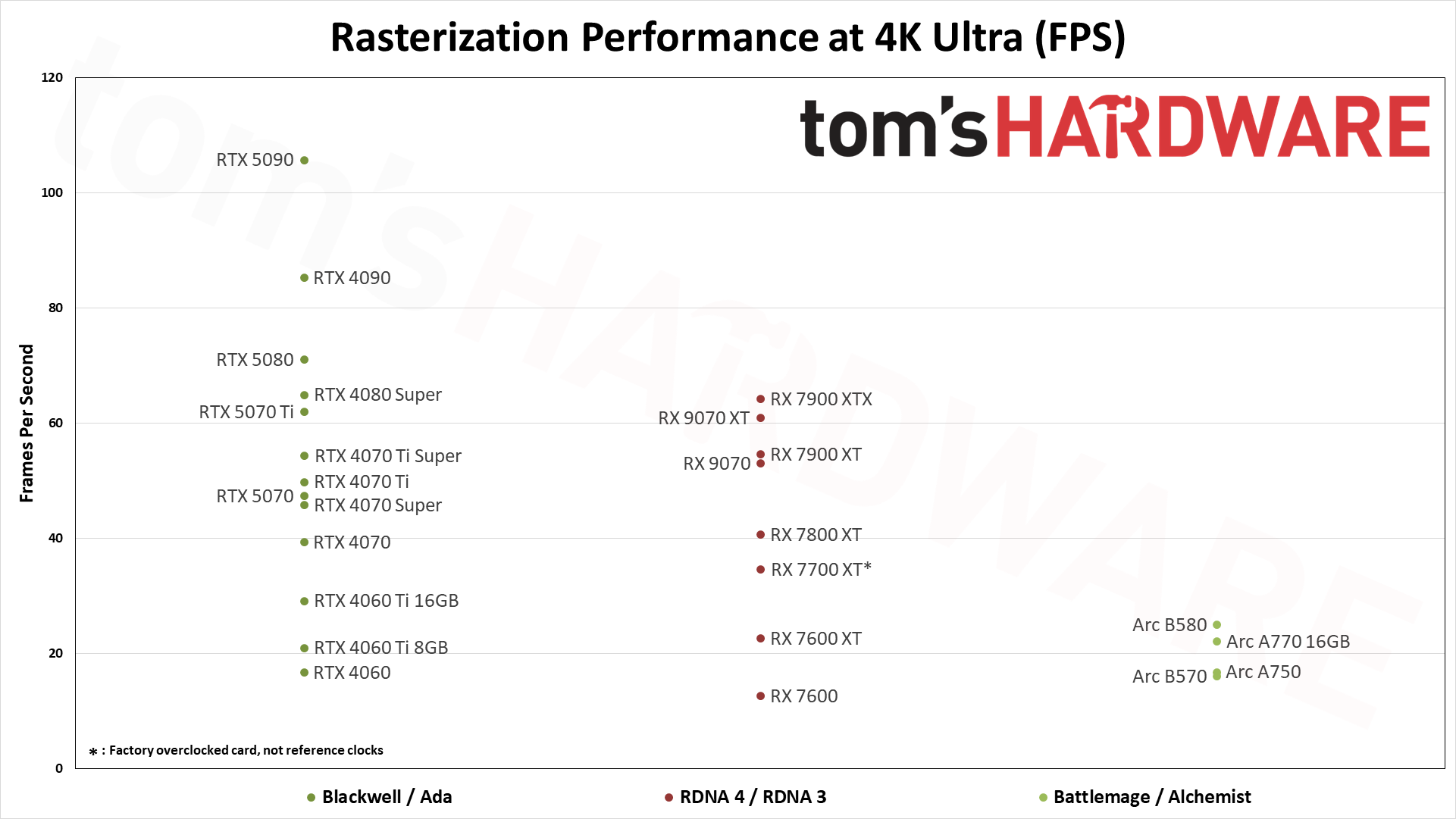



Rasterization GPU Benchmarks, Key Findings
- While the RTX 5090 takes the top spot, pricing is extremely inflated and has been since launch. It's also largely CPU limited at anything below 4K ultra.
- The latest cards typically match previous gen GPUs that are one or two model tiers "higher" (e.g. RTX 5070 roughly matches the RTX 4070 Ti Super, and RX 9070 XT roughly equals the RX 7900 XTX).
- The best GPU value in FPS per dollar at 1080p and 1440p is the Arc A750. At 4K ultra, the best FPS/$ comes from the RTX 5070. However, the prices on nearly all of the GPUs are inflated and extremely volatile.
- Testing is ongoing and there are quite a few cards we still need to test on the new suite.
Rasterization GPU Benchmarks Rankings 2025
Keep in mind that we're not including any ray tracing or DLSS results in the above table, as we use the same test suite with the same settings on all current and previous generation graphics cards. Only RTX cards support DLSS, with FSR 2/3/4 and XeSS being less supported in general. More importantly, all three upscaling solutions offer differing image quality, and we want to keep things more directly comparable.
One thing that becomes immediately obvious is just how little separation there is between the fastest GPUs at lower resolutions. In some games, there may not even be much of a difference between the 5090 and 4090 at 4K ultra if you're running in pure rasterization mode. Baldur's Gate 3 and Assassin's Creed Mirage for example show a 10% or less delta between the two fastest GPUs. Looking at the overall results, while the 5090 ends up 24% faster than the 4090 at 4K, it's only 13% faster at 1440p, 5% faster at 1080p ultra, and just 1.5% faster at 1080p medium.
There's still a sizeable gap between the second place 4090 and the third place 5080 as well. The 4090 leads by 20% at 4K, 13% at 1440p, 12% at 1080p ultra, and 9% at 1080p medium. Looking at AMD's fastest GPU, the RX 7900 XTX still edges out the 9070 XT, though only by 3–6 percent — with the largest leads again at 4K. AMD's top solution also comes in slightly behind Nvidia's RTX 4080 Super, which sits in fourth place overall.
What about Intel? The Arc B580 represents Team Blue's top solution, but it's very much a budget to mainstream part. It's faster than the RTX 4070 and RX 7600 XT, while ostensibly costing less than either of those. However, street prices are currently starting at around $350, which makes it less compelling. We don't have the 4060 Ti in the charts yet, but based on previous testing we'd expect it to be just slightly faster than the B580 overall — and also quite a bit more expensive. We'll need to see where Nvidia's upcoming RTX 5060 and AMD's RX 9060 land relative to the B580 to declare a budget winner for this generation of GPU architectures.
We'll hold off on further analysis for now — check the next page to see where older generation GPUs land. Hopefully, prices become a bit more palatable by the time we've finished additional tests. But let's switch over to the ray tracing hierarchy.

Ray Tracing GPU Benchmarks 2025
Enabling ray tracing, particularly with the most demanding games, can cause framerates to drop off a cliff. We're testing with "medium" and "ultra" ray tracing settings. Medium generally means using the medium graphics preset but turning on ray tracing effects (set to "medium" if that's an option; otherwise, "on"), while ultra turns on all of the RT options at more or less maximum quality.
The four ray tracing games we're using right now are Avatar: Frontiers of Pandora (a lighter RT title), Cyberpunk 2077 (heavy RT), F1 24 (lighter RT), and Spider-Man: Miles Morales (moderate RT) — all of these use the DirectX 12 / DX12 Ultimate API. The fps score is the geometric mean (equal weighting) of the four games, and the percentage is scaled relative to the fastest GPU in the list, which again is the GeForce RTX 5090.
If you want to see what truly heavy amounts of ray tracing can do, check out our Alan Wake 2 benchmarks where the full path tracing barely manages playable performance even with upscaling on non-Nvidia GPUs. However, and this is a critical point, the number of games where RT truly makes a striking difference in visuals is extremely limited. For most games, we still feel running pure rasterization rendering makes more sense.




Ray Tracing GPU Benchmarks, Key Findings and Notes
- The RTX 5090 stretches its legs a bit more with RT enabled, as expected.
- AMD's RX 9070 XT outperforms the RX 7900 XTX in our RT tests, indicating AMD's RDNA 4 enhancements aren't just fluff claims.
- The RX 9070 XT can only manage a tie with the RTX 4070 Ti Super, coming in tenth place overall.
- Based on current street prices, the Arc A750 still lays claim to the best bang for the buck at 1080p and 1440p, with the RTX 5070 taking the top spot at 4K.
- We are currently running additional tests and had to drop a couple of DXR games from our test suite due to performance issues and game patches. We'll be adding Control Ultimate Edition back in once testing is complete, along with Indiana Jones and the Great Circle.
Ray Tracing GPU Benchmarks Rankings 2025
Ray tracing pushes the GPUs a lot harder, depending on the game, which results in a wider performance spread across the GPUs we've tested. The 5090 still takes the pole position, with the 4090 in second place, but now there's at least an 8% gap at 1080p, and that increases to 17% at 1440p and 27% at 4K.
The gap between the 4090 and 5080 is also wider at 1440p and 4K, where the previous generation part is 17% and 24% faster, respectively. That's without enabling MFG of course, but we wouldn't take MFG framerates at face value.
AMD's fastest ray tracing GPU is the new RX 9070 XT, outpacing the 7900 XTX across all tested resolutions. It's 8–11 percent faster, with the biggest gap at 4K — at resolution where normally the extra memory and bandwidth of the XTX would come into play. But the 9070 XT can only trade blows with the RTX 4070 Ti Super, winning by a tiny amount at 1080p medium and 1440p ultra, and losing by an equally tiny amount at 1080p ultra and 4K ultra.
Intel's Arc B580 still leads the A770, by a slightly larger margin this time. It's also generally a better pick than the RTX 4060 due to the lack of VRAM on Nvidia's card, assuming prices are similar. AMD's budget RX 7600 and 7600 XT fall off the pace with RT enabled.
Content Creation GPU Benchmarks Rankings 2025
With our new 2025 test suite, we're also benchmarking every GPU possible in content creation tasks. These consist of AI workloads like Stable Diffusion 1.5/XL, Procyon's AI Vision suite, MLPerf Client 0.5, SPECworkstation 4.0, and Blender. For gamers, most of these test results are superfluous, but those who plan to use their GPU for other tasks may find the information to be useful.
The individual test results in this suite can swing wildly, depending on the GPU in question, which makes the overall rankings a bit harder to determine. We've used the geometric mean of all the benchmarks for the score, but it's important to check the individual application results for the workloads you plan on running. We've included the charts directly below the main table for our Content Creation GPU Hierarchy.






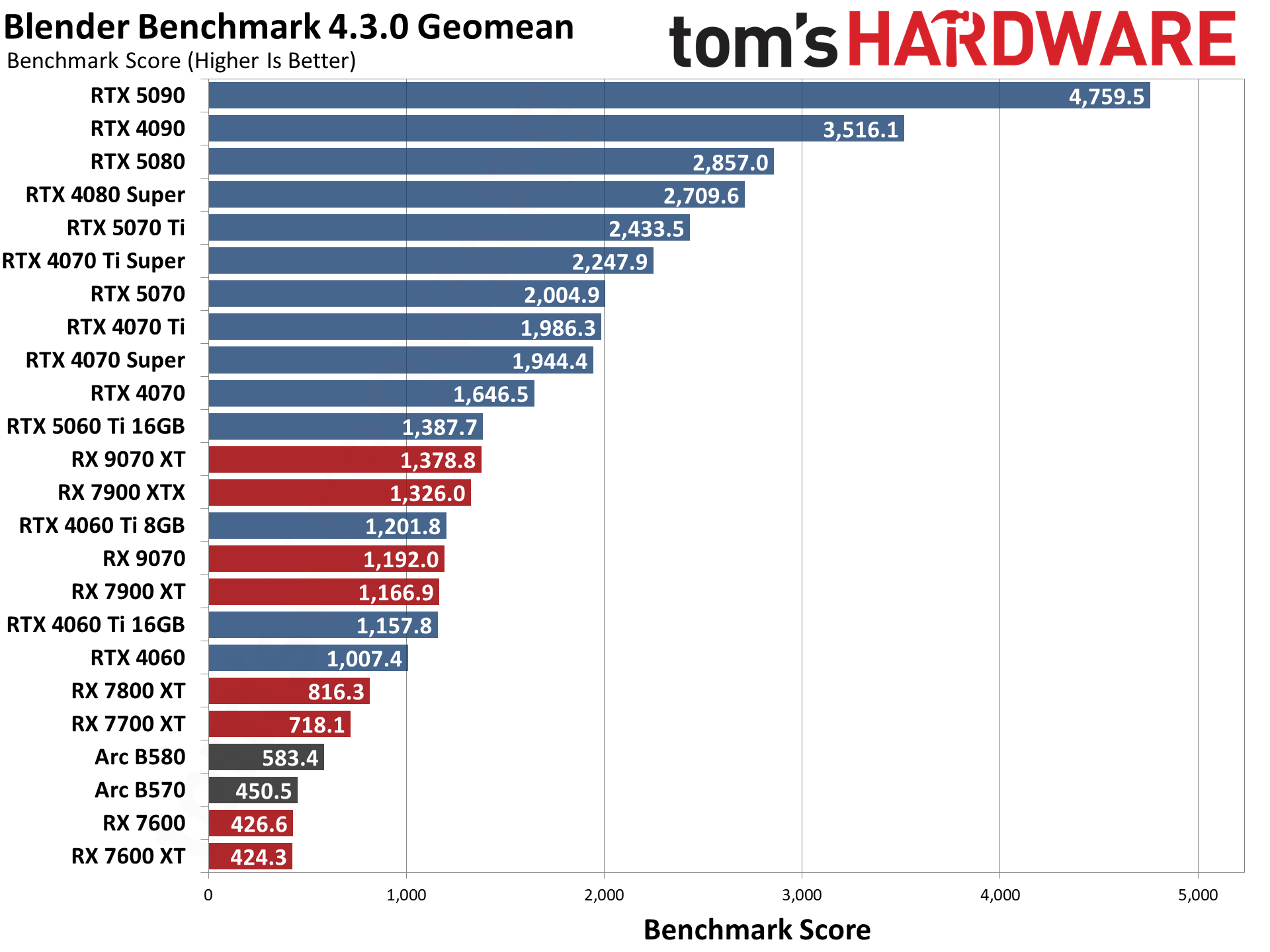

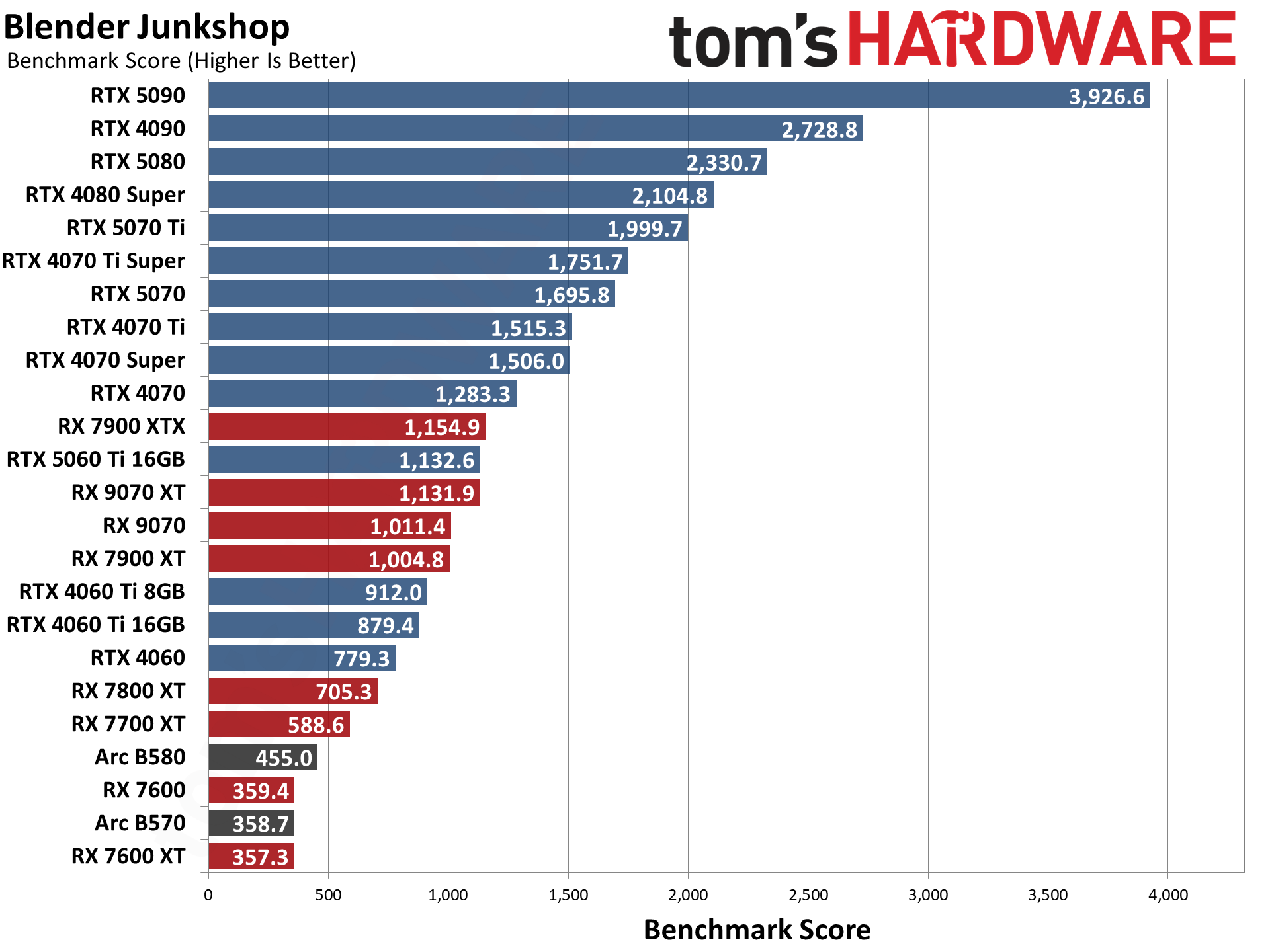
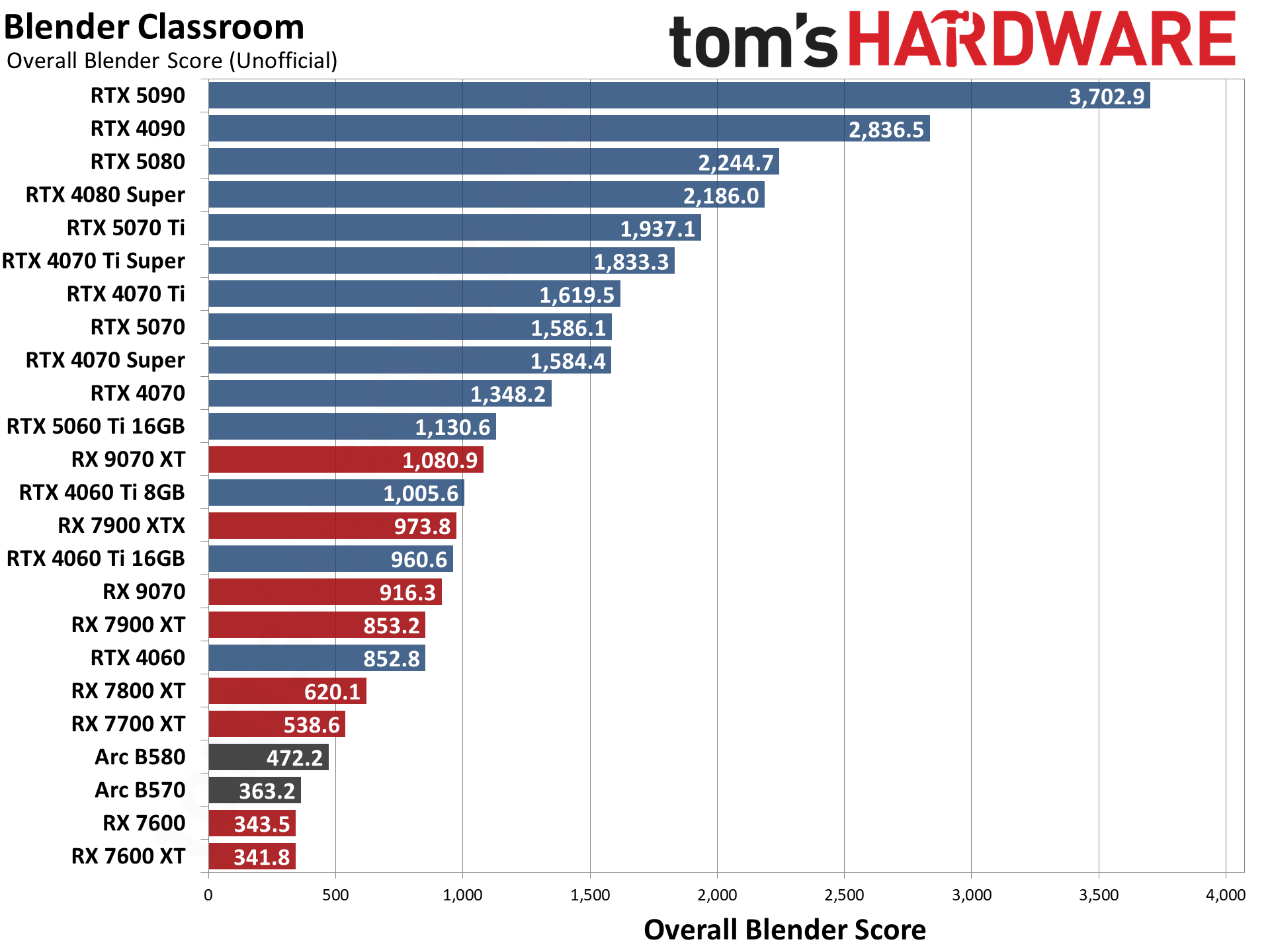



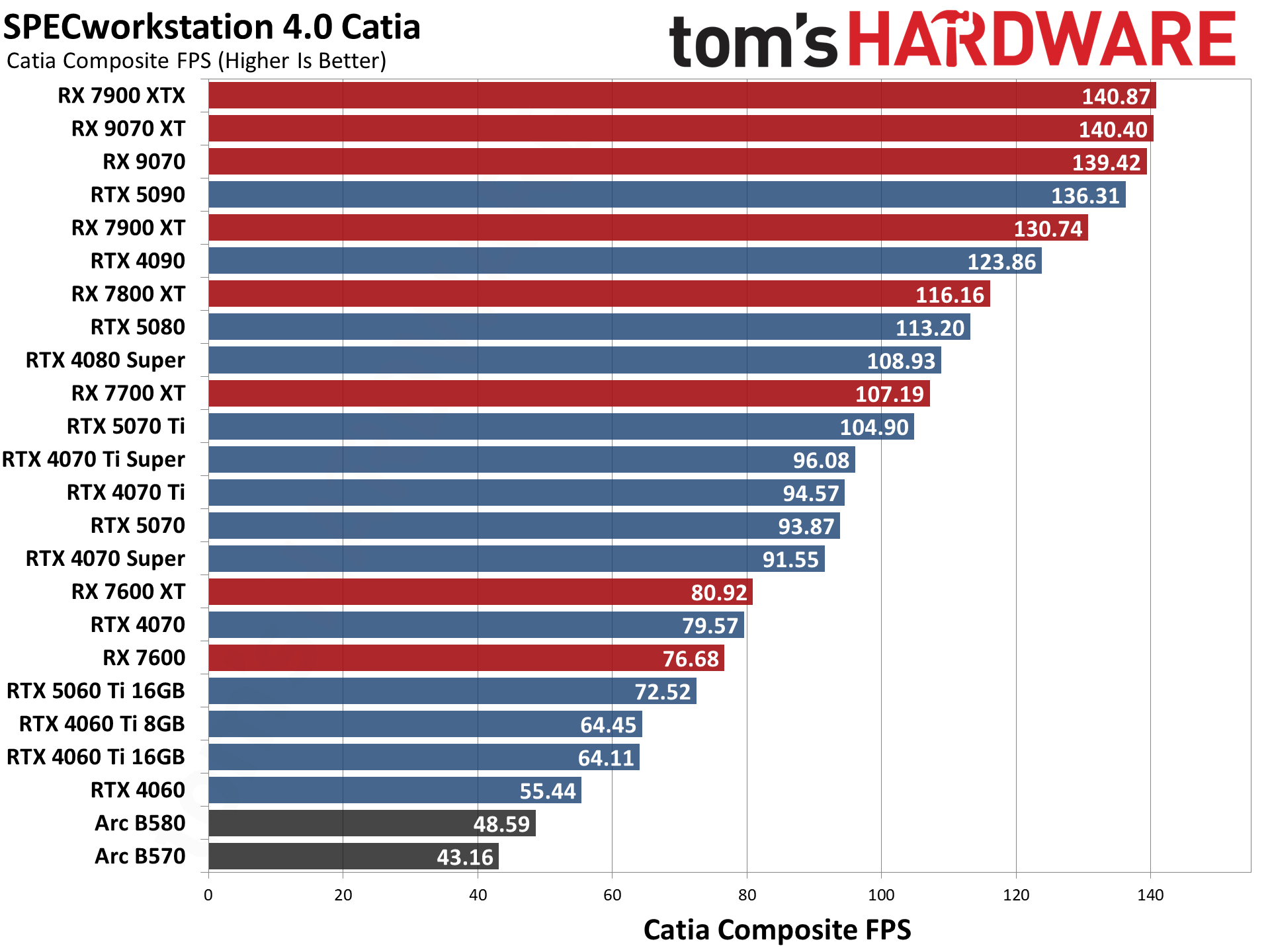






Nvidia's RTX 50- and 40-series GPUs absolutely dominate in the Stable Diffusion AI workloads as well as in Blender 3D rendering. MLPerf Client shows Nvidia generally in the lead as well, with AMD GPUs doing poorly in the Time to First Token metric, but the Tokens per Second results look much closer than some of the other AI tests.
The Procyon AI Vision suite also heavily favors Nvidia GPUs and even the new Intel Arc Battlemage chips rank ahead of AMD, but AMD's chips have to run that particular test in FP16 mode, while Intel and Nvidia perform substantially better with optimized INT8 pathways using OpenVINO and TensorRT, respectively.
SPECworkstation 4.0's GPU inference tests still favor Nvidia, but AMD closes the gap — and Intel falls to the bottom of the list. The Handbrake video transcoding tests only focus on raw throughput, without regards to encoding quality, with Intel's Battlemage and AMD's new RDNA 4 GPUs basically tied at the top, then there's a step down to the AMD RDNA 3 GPUs, and finally all the Nvidia GPUs clump together — though the Blackwell RTX 50-series cards do land slightly ahead of the older 40-series parts.
Finally, we have SPECworkstation's Viewport test suite, an updated selection of the tests used in SPECviewperf 2020. AMD's drivers offer more tuning for these tasks, while Nvidia restricts performance for the non-professional GPUs. Certain tests favor Nvidia still (3ds Max and Solidworks) while others (Catia, Creo, Energy, and Medical) heavily favor AMD's GPUs and drivers. Intel's drivers are not particularly optimized for these tests and so the Battlemage GPUs are mostly in the bottom two positions — which isn't entirely unexpected considering they're also the two least expensive GPUs that we've tested in our Content Creation suite.
Test Setup and Hardware for GPU Benchmarks
We've used several different PCs for our testing over the years. The latest 2025 update switches to an AMD Zen 5 X3D processor, the Ryzen 7 9800X3D. Here are the specifications for our latest GPU test PC.
Tom's Hardware 2025 GPU Benchmarks Testbed
AMD Ryzen 7 9800X3D
ASRock X670E Taichi
Corsair 2x16GB DDR5-6000 CL30
Crucial T700 4TB
Corsair HX1500i Platinum
Cooler Master MasterLiquid Pro 280 RGB
Windows 11 Pro 64-bit 24H2
For each graphics card, we follow the same testing procedure. We run one pass of each benchmark to "warm up" the GPU after launching the game, then run at least two passes at each setting/resolution combination. If the two runs are basically identical (within 0.5% or less difference), we use the faster of the two runs. If there's more than a small difference, we run the test at least twice more to determine what "normal" performance is supposed to be.
We also look at all the data and check for anomalies, so for example RTX 5070 Ti should be faster than RTX 5070, unless we are CPU bottlenecked, in which case the two GPUs should be basically tied. If we see games where there are clear outliers (i.e. a 'slower' card outperforms a 'faster' card), we'll go back and retest whatever cards are showing the anomaly and figure out what the "correct" result would be.
Due to the length of time required for testing each GPU, updated drivers and game patches inevitably will come out that can impact performance. We periodically retest a few sample cards to verify our results are still valid, and if not, we go through and retest the affected game(s) and GPU(s). We may also add games to our test suite over the coming year, if one comes out that is popular and conducive to testing — see our what makes a good game benchmark for our selection criteria.
GPU Benchmarks: Individual Game Charts
The above tables provide a summary of performance, but for those that want to see the individual game charts, for both the standard and ray tracing test suites, we've got those as well. We're only including more recent GPUs in these charts, as otherwise things get very messy.
These charts are up to date as of April 17, 2025.
GPU Benchmarks — 1080p Medium
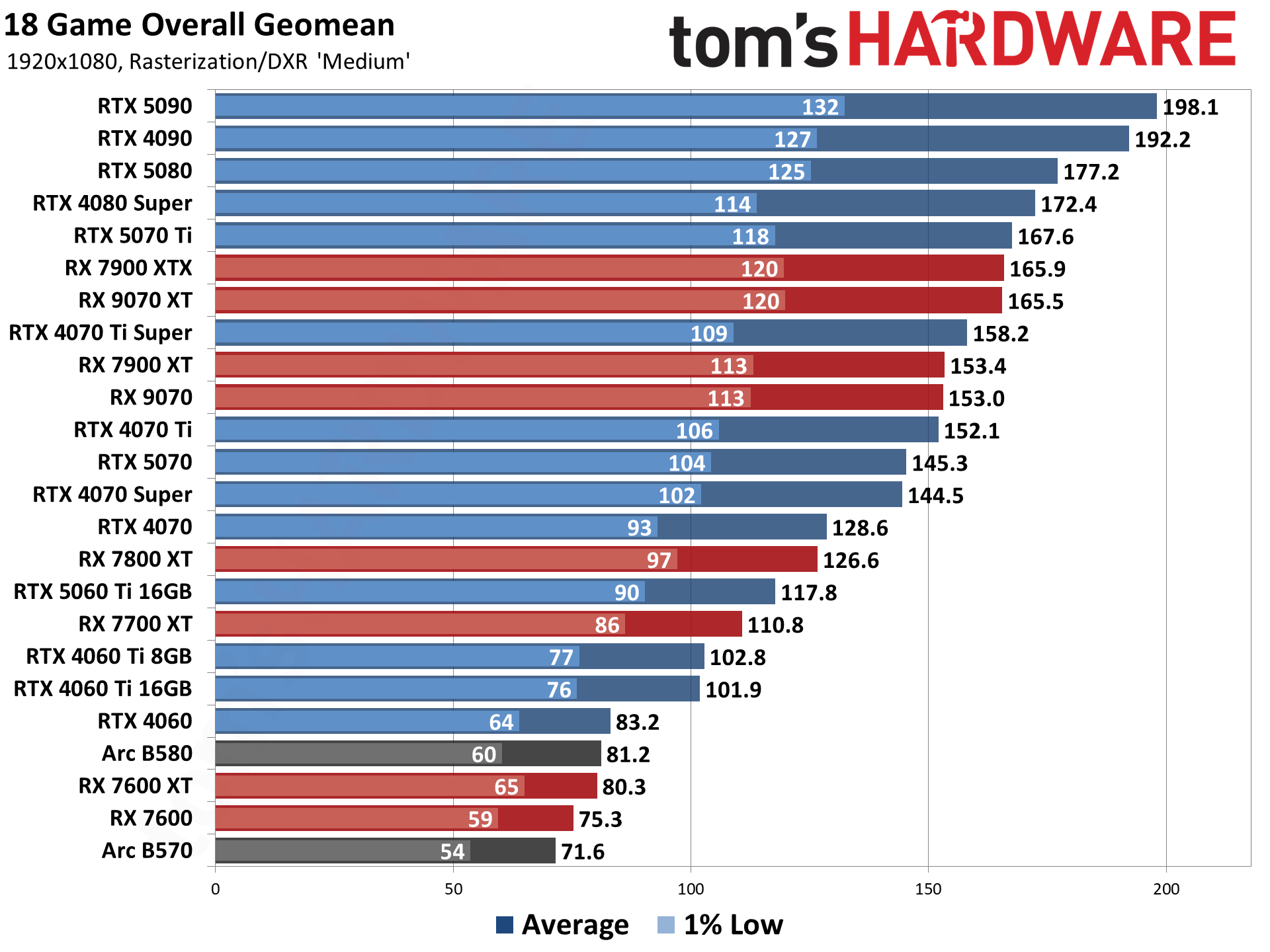













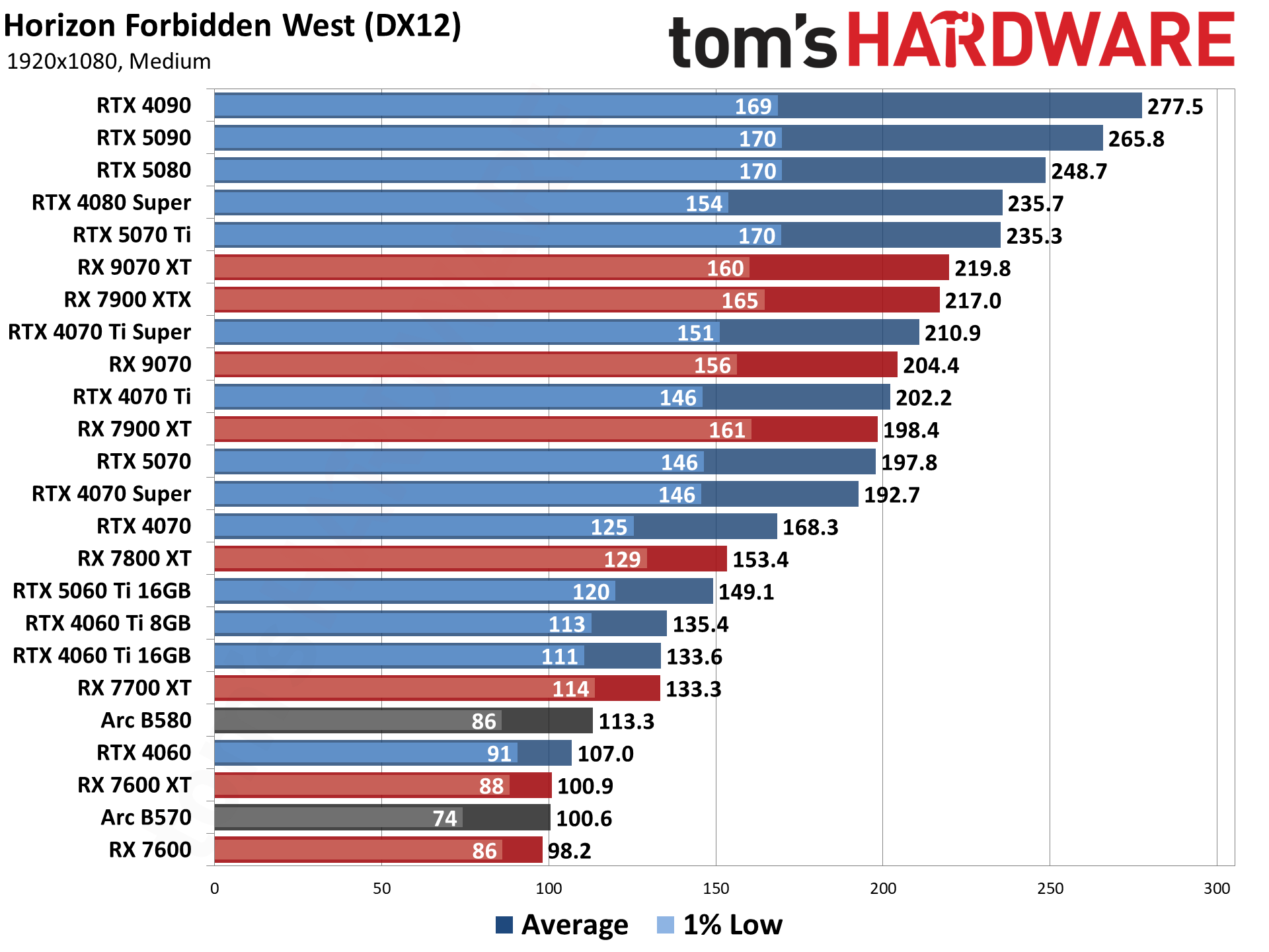




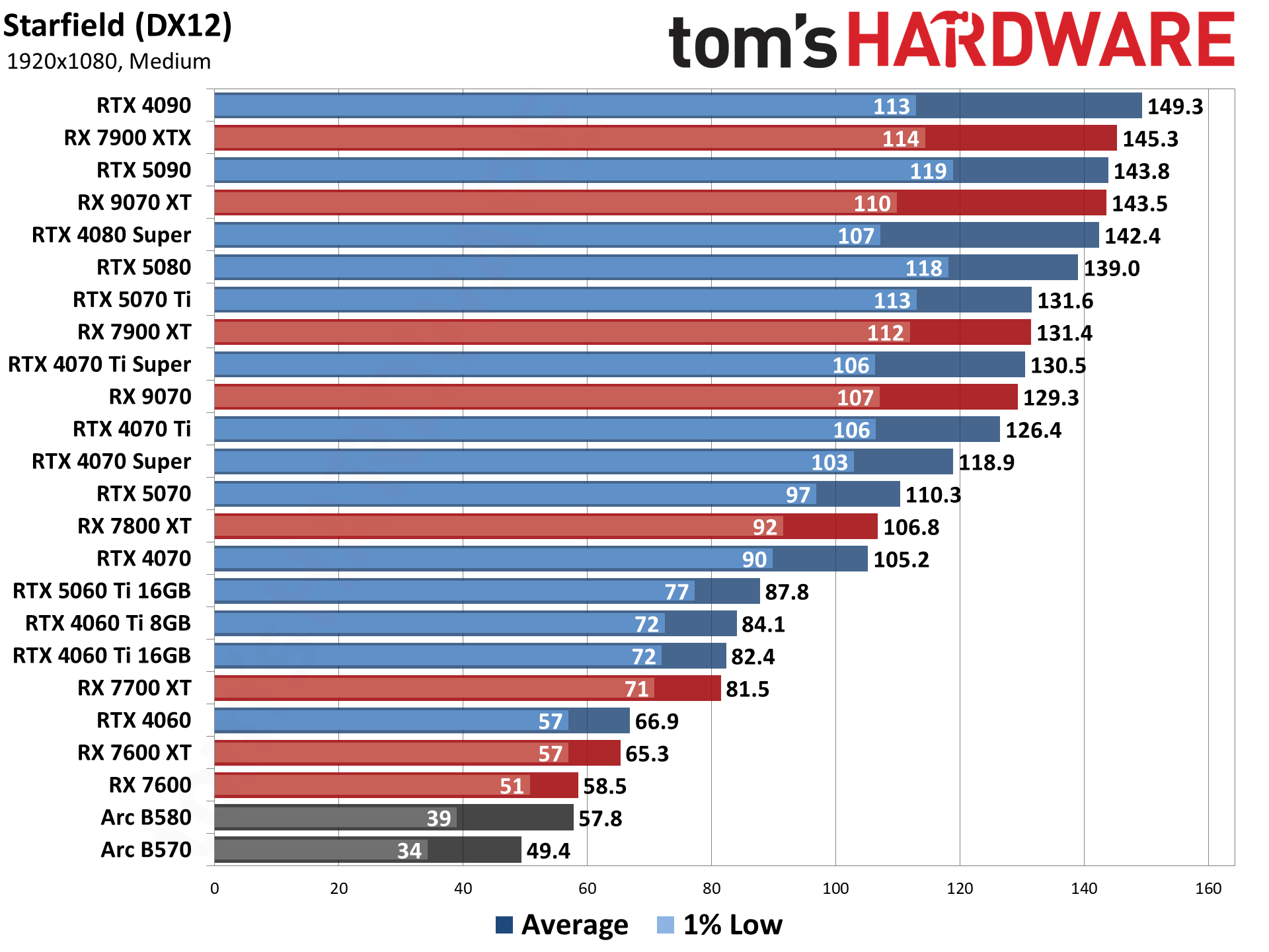

GPU Benchmarks — 1080p Ultra




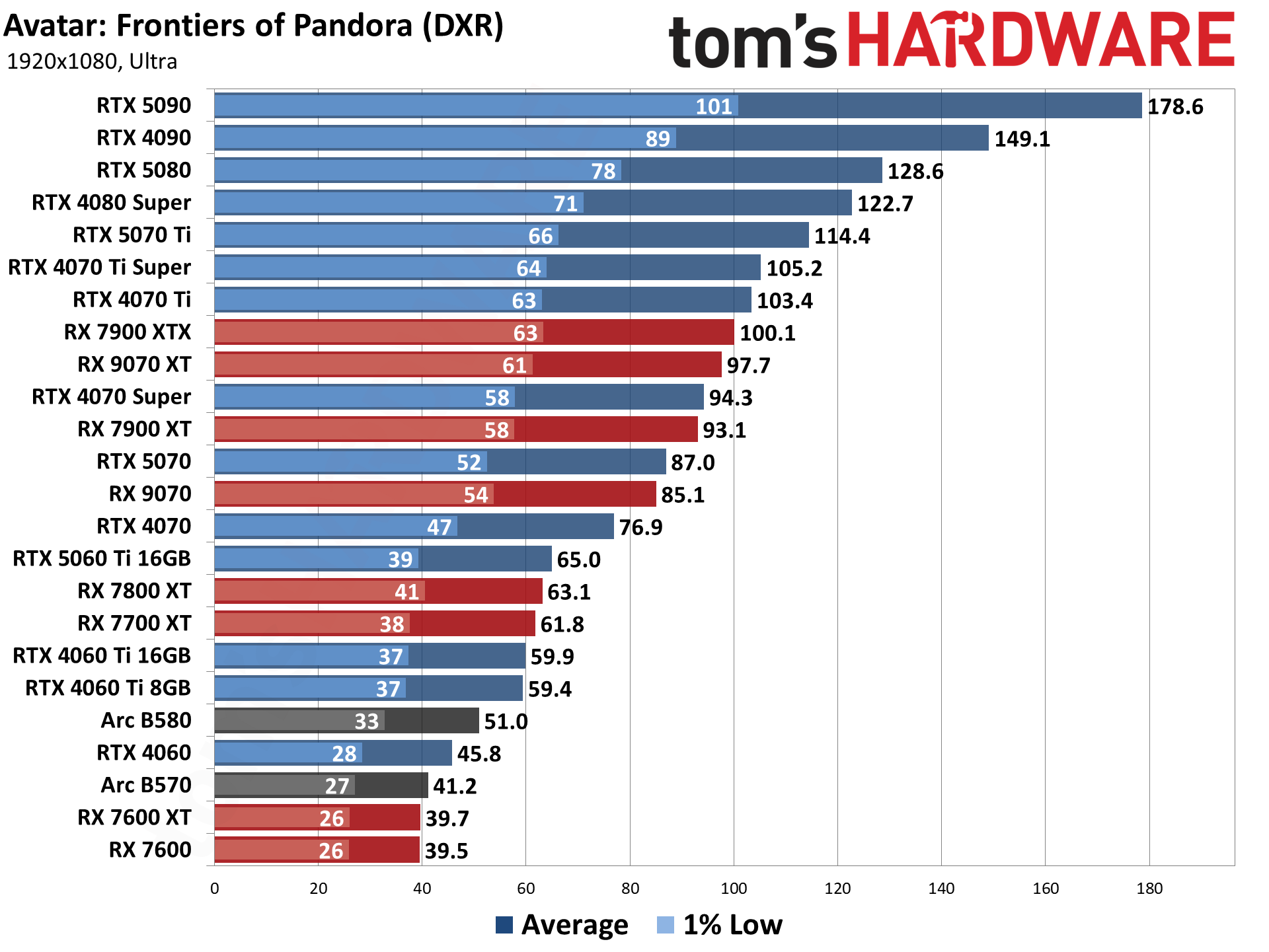


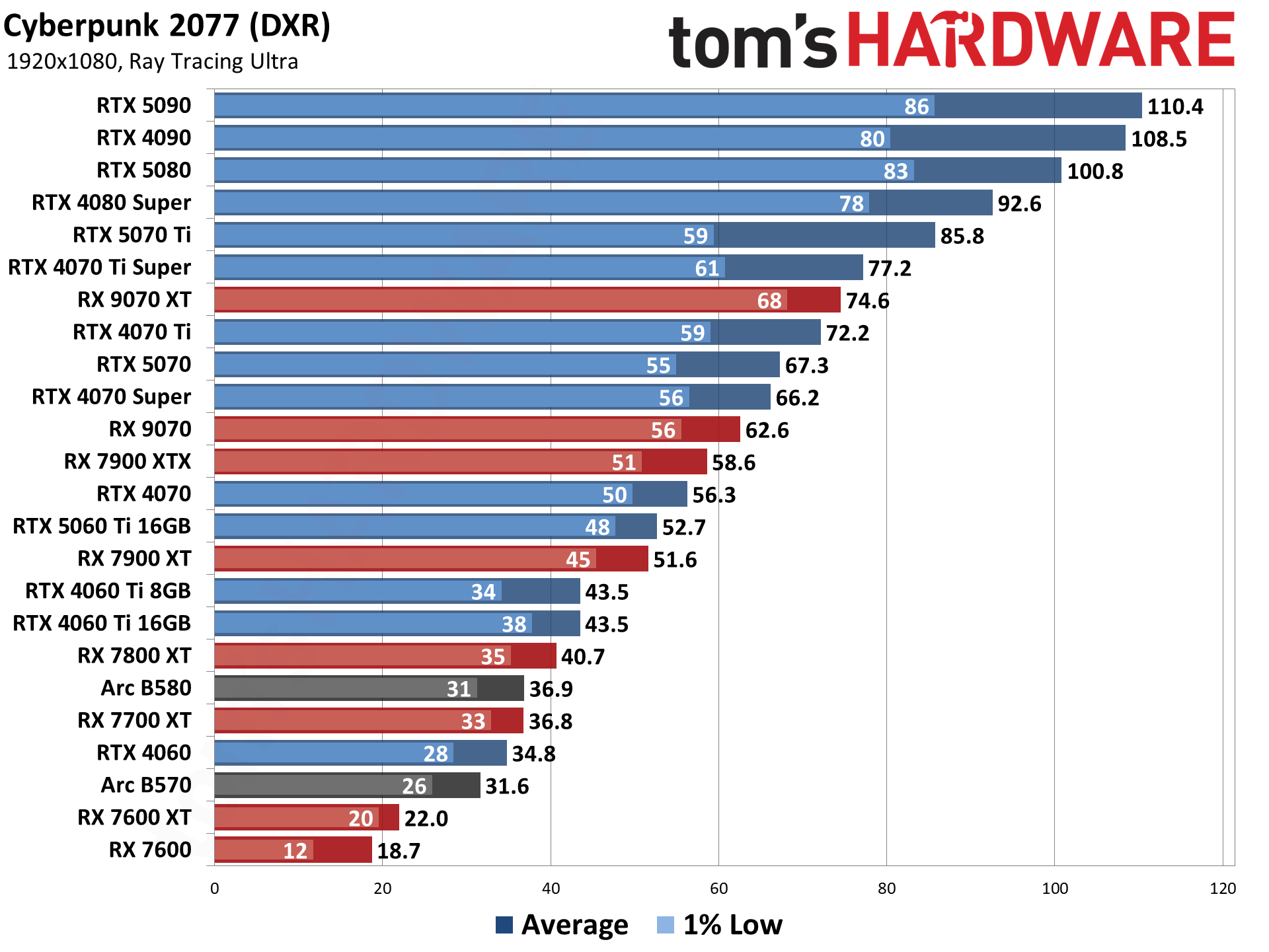





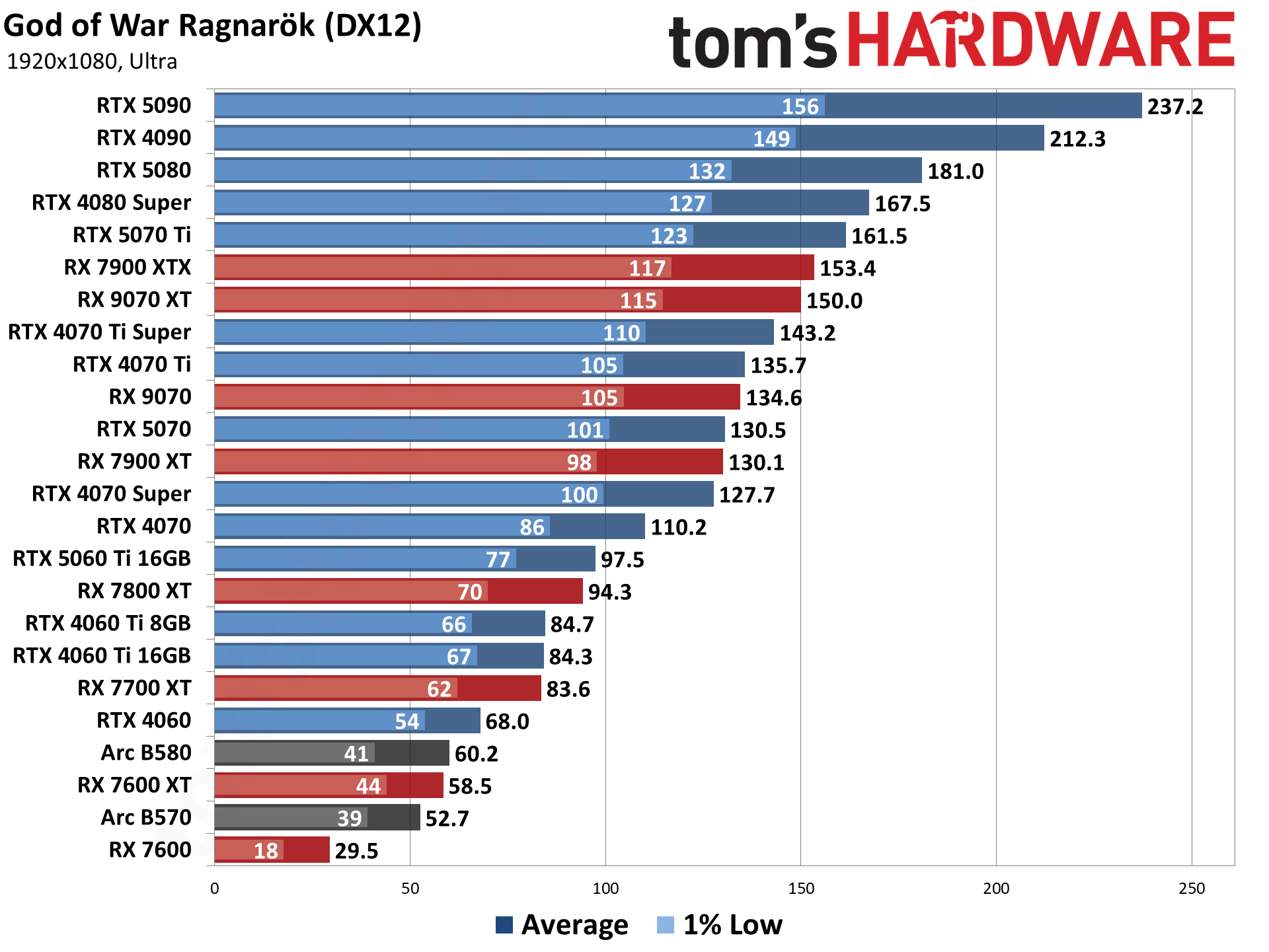

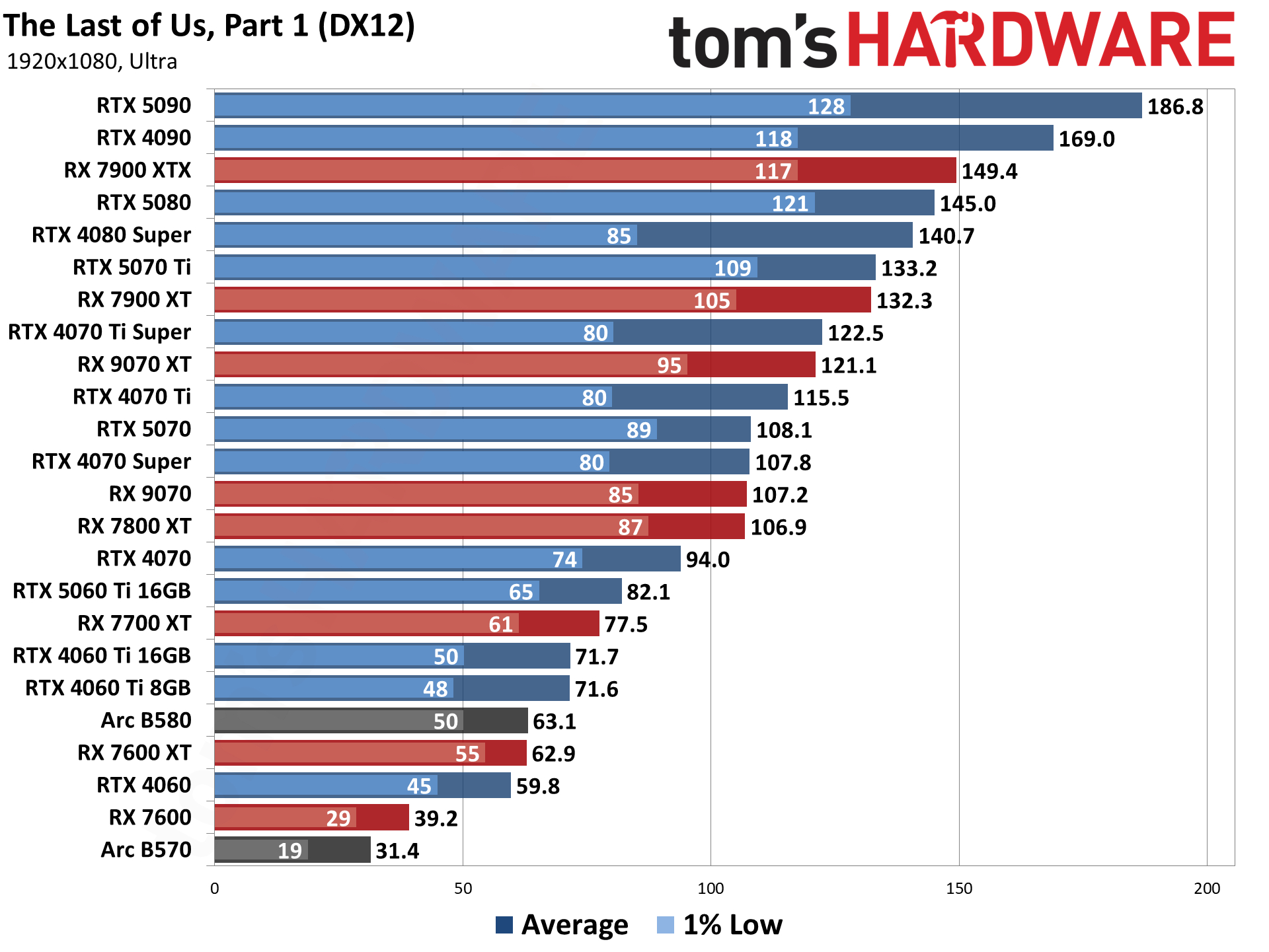





GPU Benchmarks — 1440p Ultra





















GPU Benchmarks — 4K Ultra








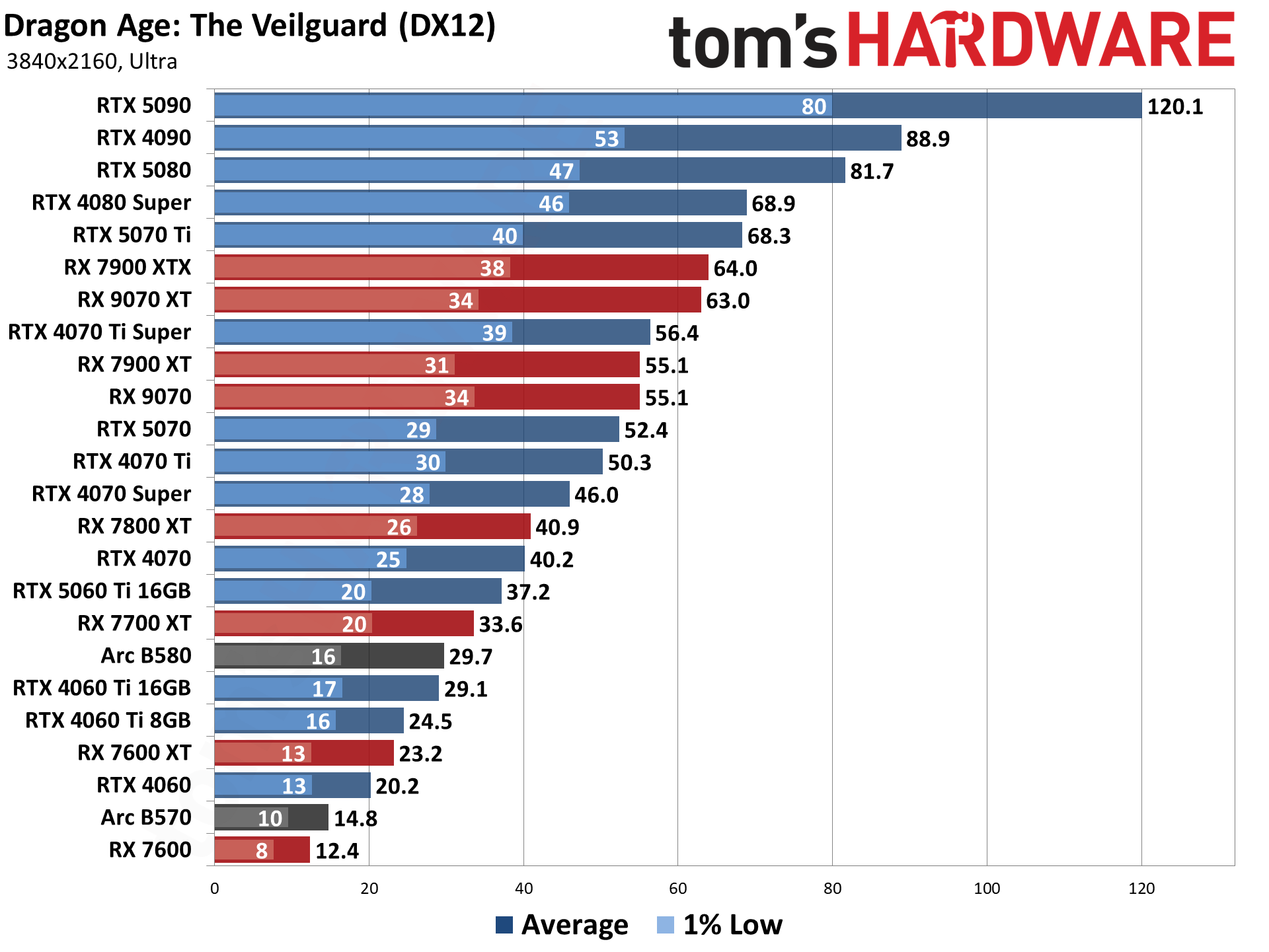







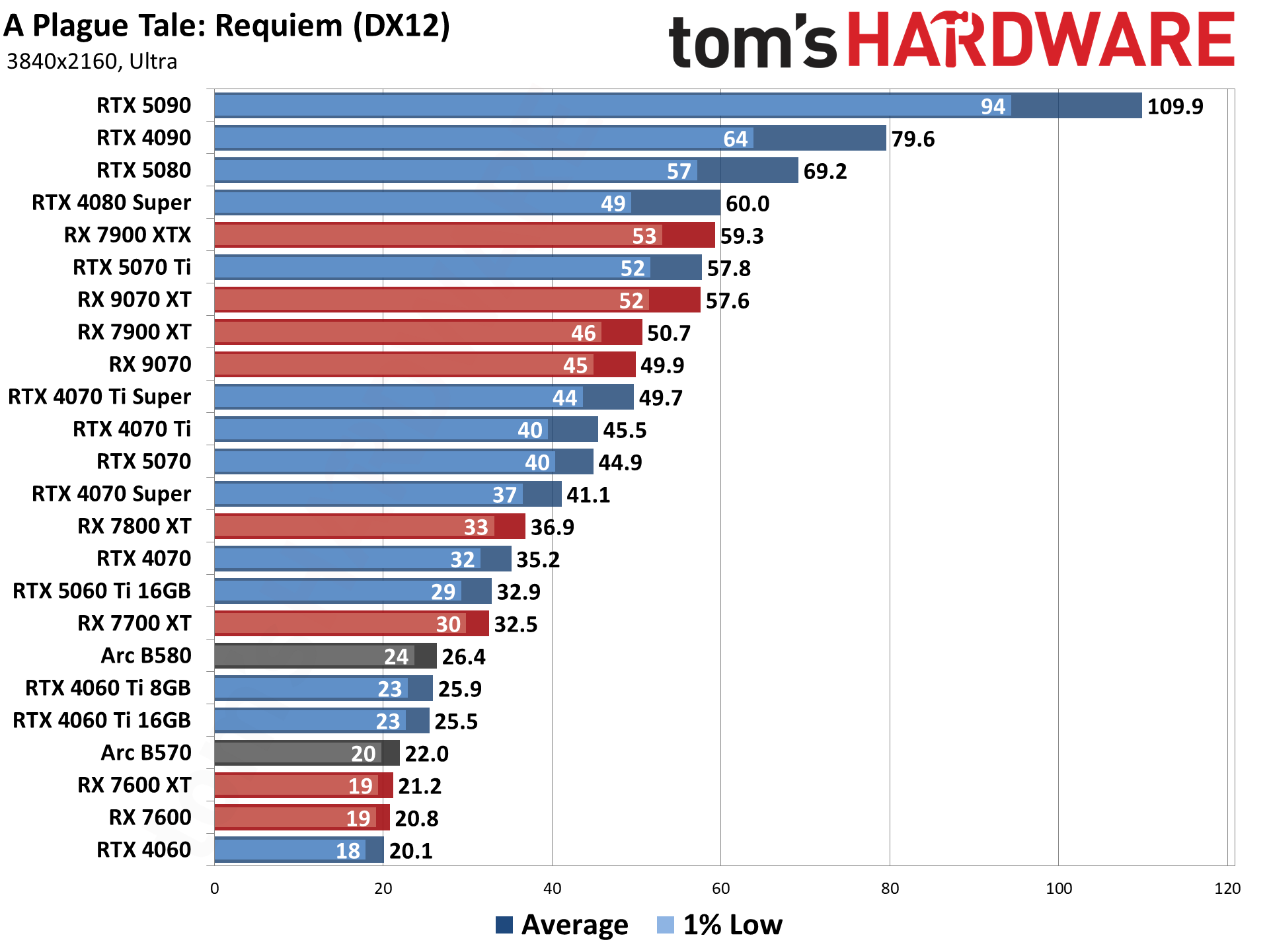



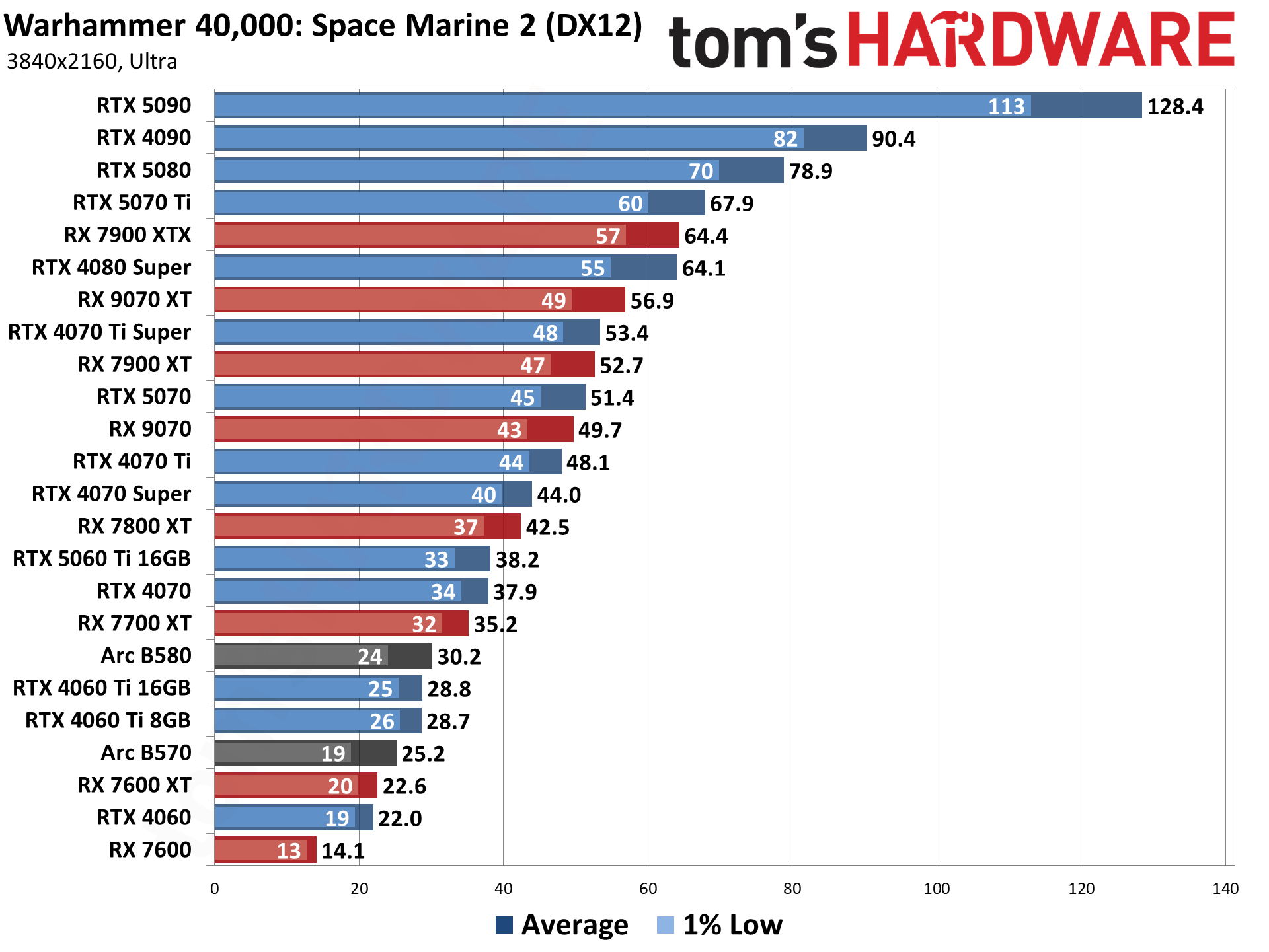
GPU Benchmarks — Power, Clocks, and Temperatures
Most of our discussion has focused on performance, but for those interested in power and other aspects of the GPUs, here are the appropriate charts. We'll run these from highest to lowest settings, as 4K ultra tends to be the most strenuous workload on most of these GPUs.
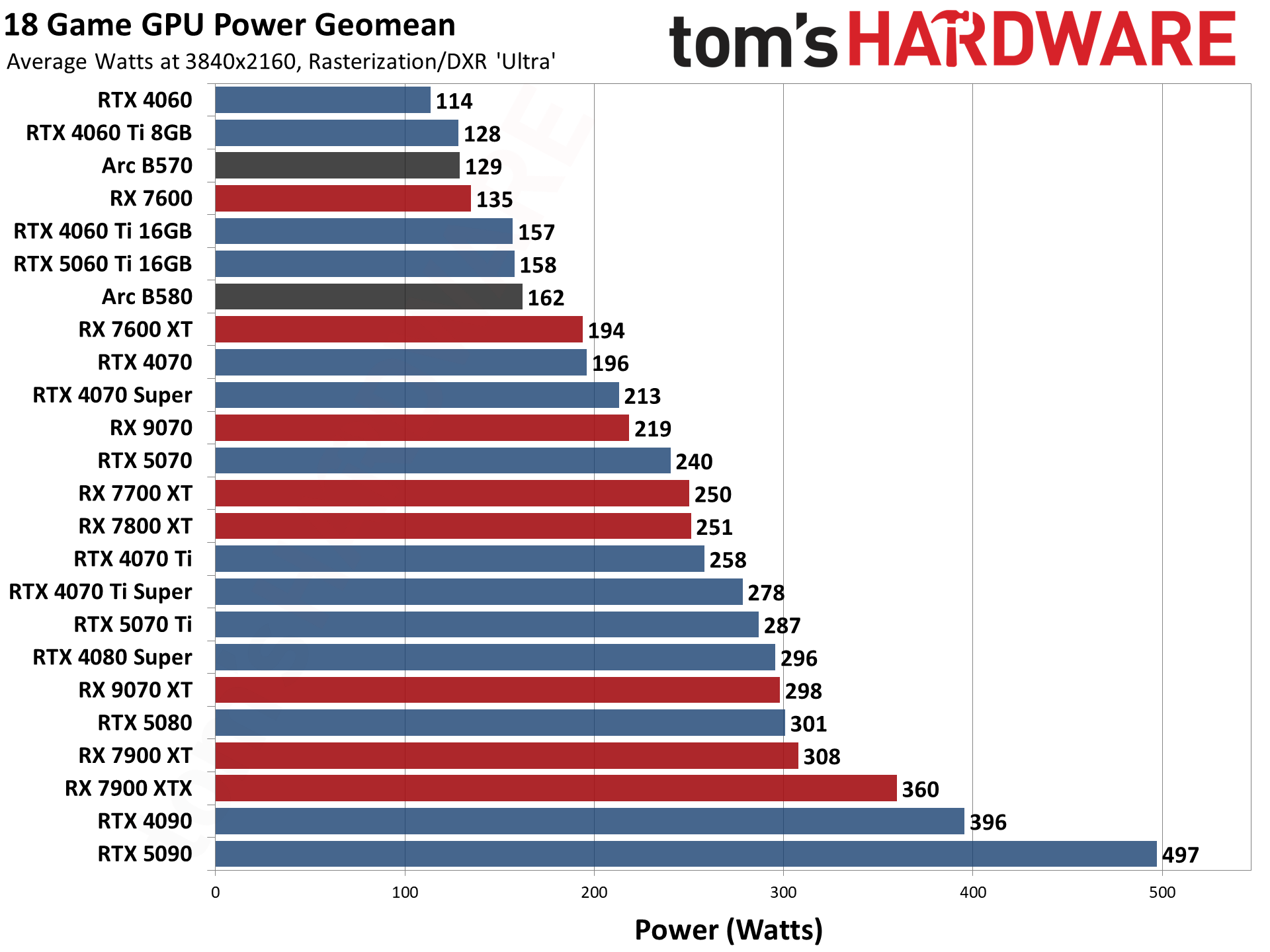


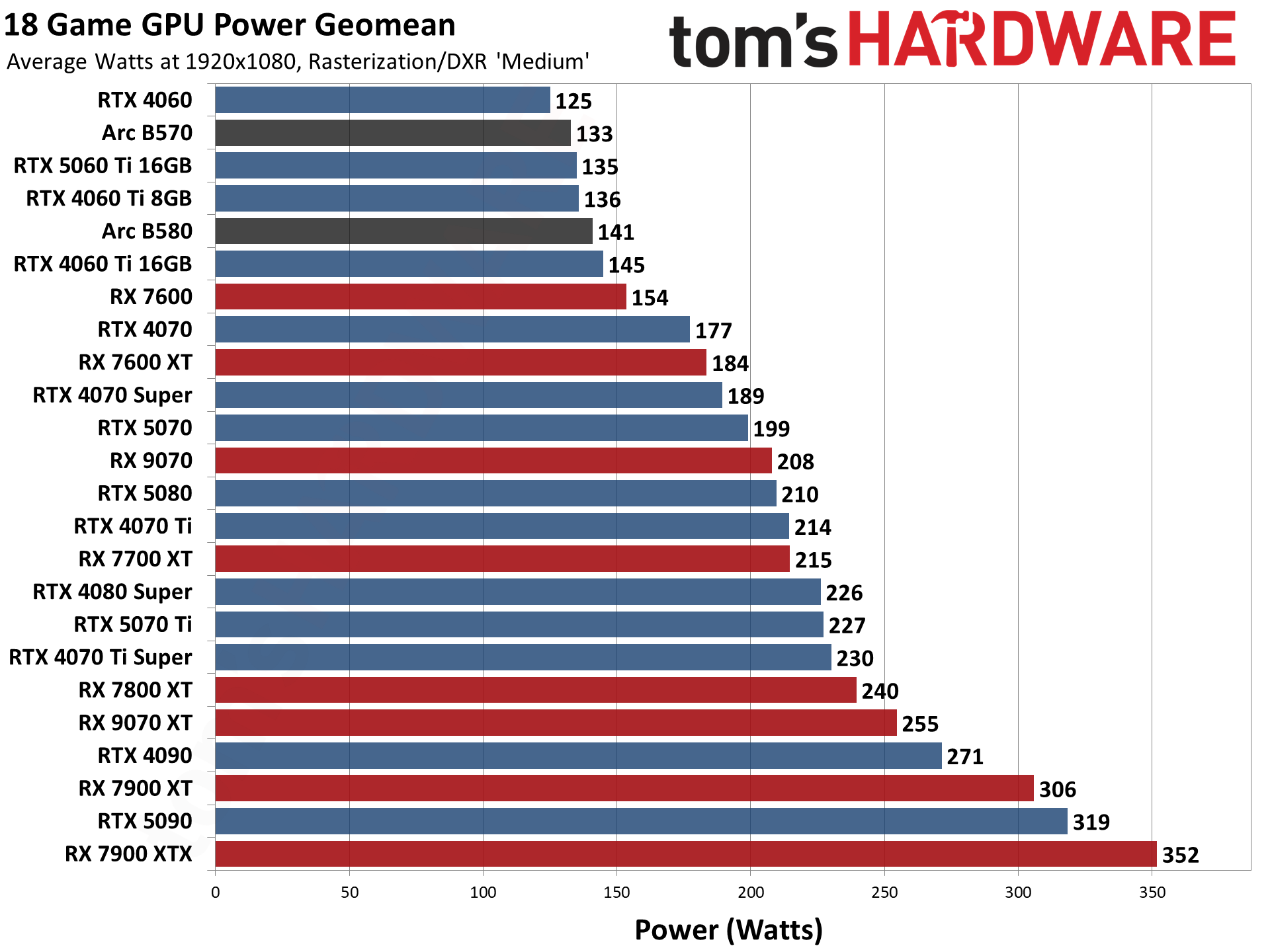
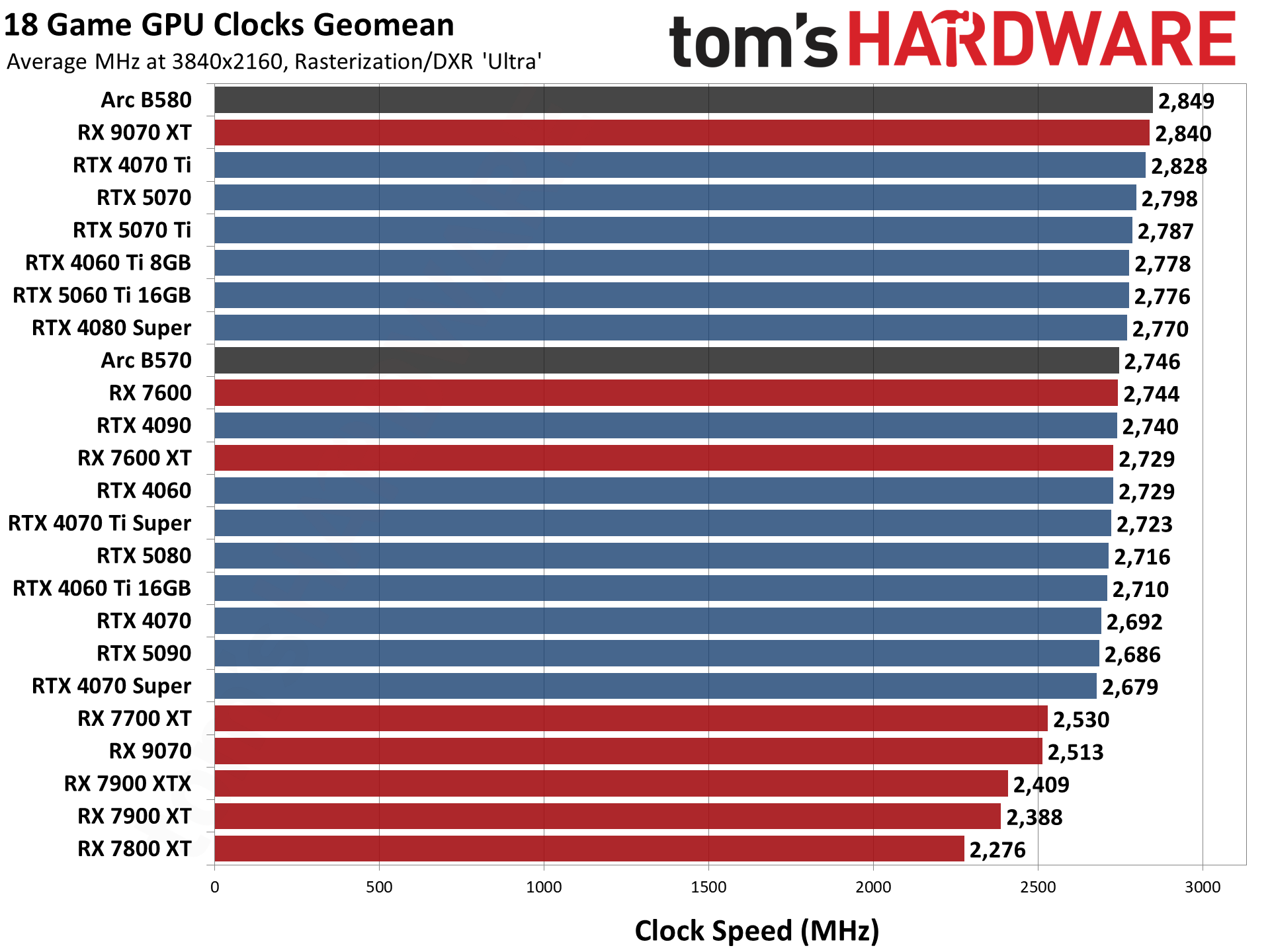

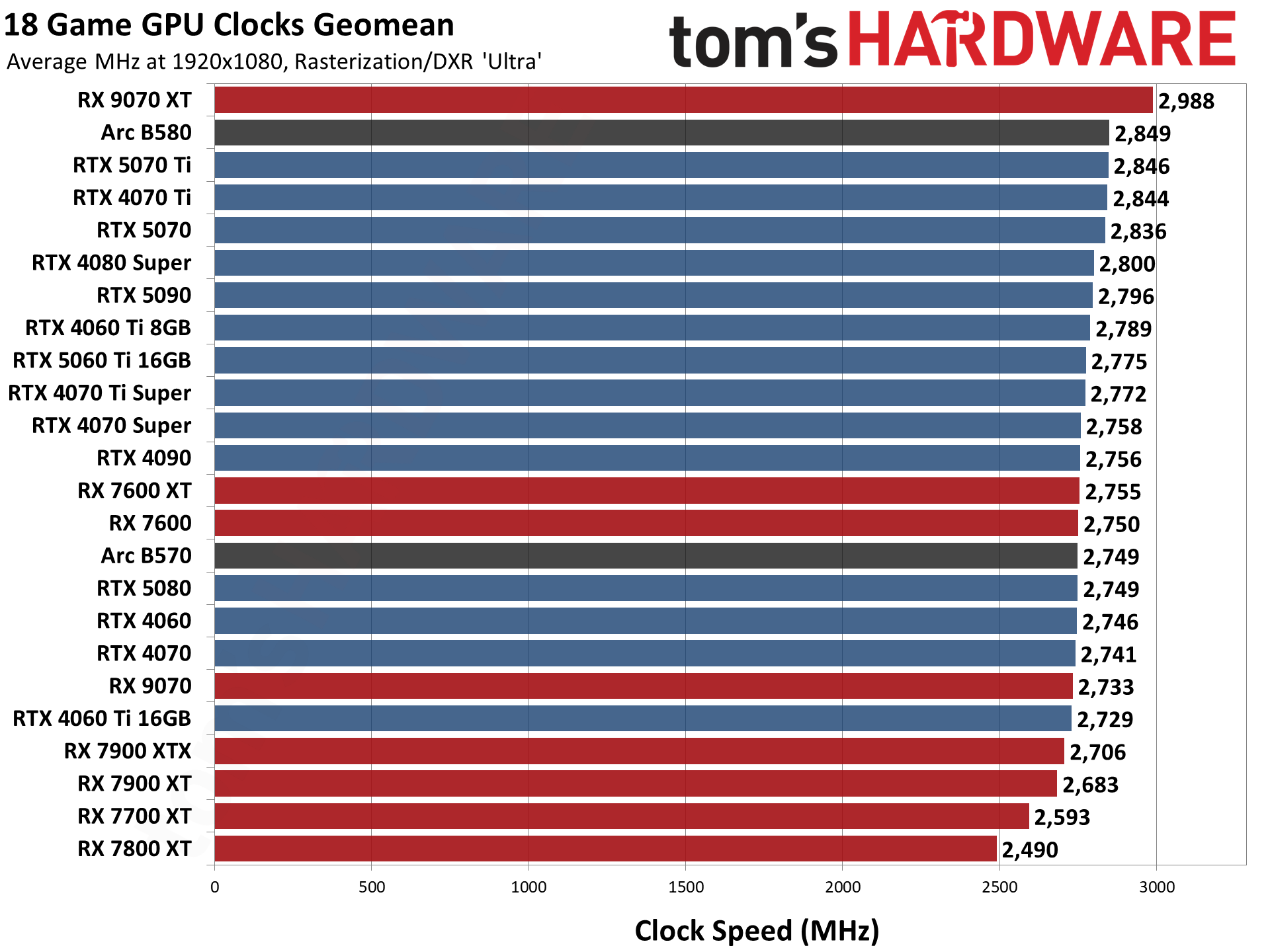



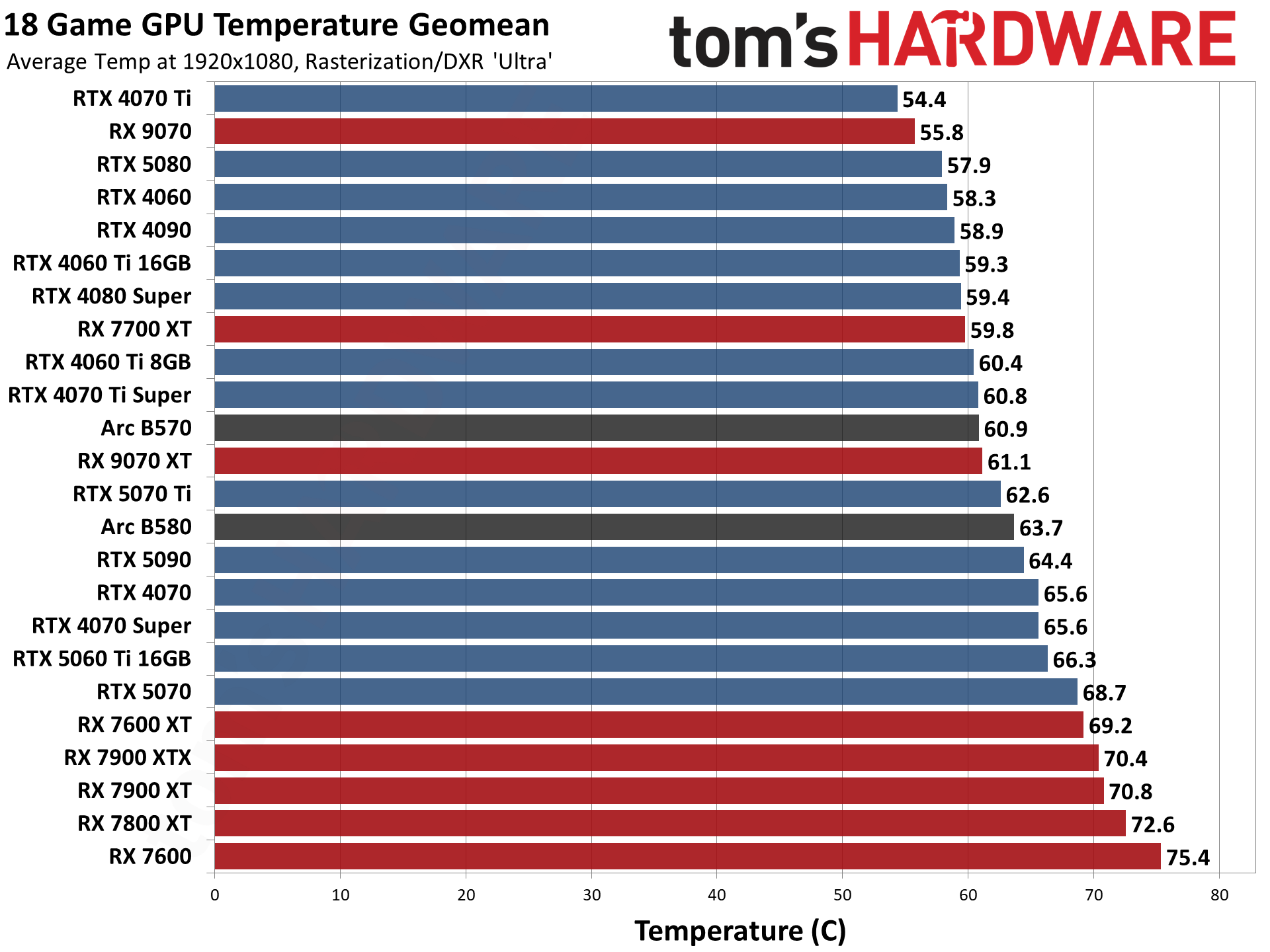

If you're looking for the legacy GPU hierarchy, head over to page two! We moved it to a separate page to help improve load times in our CMS as well as for the main website. And if you're looking to comment on the GPU benchmarks hierarchy, head over to our forums and join the discussion!
Choosing a Graphics Card
Choosing a Graphics Card
Which graphics card do you need? To help you decide, we created this GPU benchmarks hierarchy consisting of dozens of GPUs from the past four generations of hardware. Not surprisingly, the fastest cards are using the latest GPU architectures, though they're not always a major upgrade over the prior generation.
Of course it's not just about playing games. Many applications use the GPU for other work, and we cover professional GPU benchmarks in our full GPU reviews. But a good graphics card for gaming will typically do equally well in complex GPU computational workloads. Buy one of the top cards and you can run games at high resolutions and frame rates with the effects turned all the way up, and you'll be able to do content creation work as needed. Drop down to the middle and lower portions of the list and you'll need to start dialing down the settings to get acceptable performance in regular game play and GPU benchmarks.
If your main goal is gaming, you can't forget about the CPU. Getting the best possible gaming GPU won't help you much if your CPU is underpowered and/or out of date. So be sure to check out the Best CPUs for gaming page, as well as our CPU Benchmarks Hierarchy to make sure you have the right CPU for the level of gaming you're looking to achieve.
Stay On the Cutting Edge: Get the Tom's Hardware Newsletter
Get Tom's Hardware's best news and in-depth reviews, straight to your inbox.
Jarred Walton is a senior editor at Tom's Hardware focusing on everything GPU. He has been working as a tech journalist since 2004, writing for AnandTech, Maximum PC, and PC Gamer. From the first S3 Virge '3D decelerators' to today's GPUs, Jarred keeps up with all the latest graphics trends and is the one to ask about game performance.
